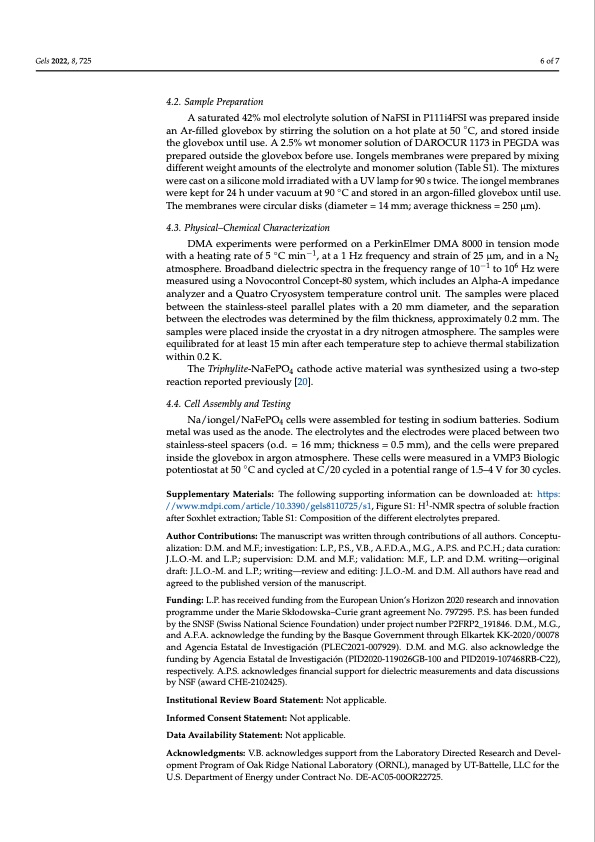
PDF Publication Title:
Text from PDF Page: 006
Gels 2022, 8, 725 6 of 7 4.2. Sample Preparation A saturated 42% mol electrolyte solution of NaFSI in P111i4FSI was prepared inside an Ar-filled glovebox by stirring the solution on a hot plate at 50 ◦C, and stored inside the glovebox until use. A 2.5% wt monomer solution of DAROCUR 1173 in PEGDA was prepared outside the glovebox before use. Iongels membranes were prepared by mixing different weight amounts of the electrolyte and monomer solution (Table S1). The mixtures were cast on a silicone mold irradiated with a UV lamp for 90 s twice. The iongel membranes were kept for 24 h under vacuum at 90 ◦C and stored in an argon-filled glovebox until use. The membranes were circular disks (diameter = 14 mm; average thickness = 250 μm). 4.3. Physical–Chemical Characterization DMA experiments were performed on a PerkinElmer DMA 8000 in tension mode with a heating rate of 5 ◦C min−1, at a 1 Hz frequency and strain of 25 μm, and in a N2 atmosphere. Broadband dielectric spectra in the frequency range of 10−1 to 106 Hz were measured using a Novocontrol Concept-80 system, which includes an Alpha-A impedance analyzer and a Quatro Cryosystem temperature control unit. The samples were placed between the stainless-steel parallel plates with a 20 mm diameter, and the separation between the electrodes was determined by the film thickness, approximately 0.2 mm. The samples were placed inside the cryostat in a dry nitrogen atmosphere. The samples were equilibrated for at least 15 min after each temperature step to achieve thermal stabilization within 0.2 K. The Triphylite-NaFePO4 cathode active material was synthesized using a two-step reaction reported previously [20]. 4.4. Cell Assembly and Testing Na/iongel/NaFePO4 cells were assembled for testing in sodium batteries. Sodium metal was used as the anode. The electrolytes and the electrodes were placed between two stainless-steel spacers (o.d. = 16 mm; thickness = 0.5 mm), and the cells were prepared inside the glovebox in argon atmosphere. These cells were measured in a VMP3 Biologic potentiostat at 50 ◦C and cycled at C/20 cycled in a potential range of 1.5–4 V for 30 cycles. Supplementary Materials: The following supporting information can be downloaded at: https: //www.mdpi.com/article/10.3390/gels8110725/s1, Figure S1: H1-NMR spectra of soluble fraction after Soxhlet extraction; Table S1: Composition of the different electrolytes prepared. Author Contributions: The manuscript was written through contributions of all authors. Conceptu- alization: D.M. and M.F.; investigation: L.P., P.S., V.B., A.F.D.A., M.G., A.P.S. and P.C.H.; data curation: J.L.O.-M. and L.P.; supervision: D.M. and M.F.; validation: M.F., L.P. and D.M. writing—original draft: J.L.O.-M. and L.P.; writing—review and editing: J.L.O.-M. and D.M. All authors have read and agreed to the published version of the manuscript. Funding: L.P. has received funding from the European Union’s Horizon 2020 research and innovation programme under the Marie Skłodowska–Curie grant agreement No. 797295. P.S. has been funded by the SNSF (Swiss National Science Foundation) under project number P2FRP2_191846. D.M., M.G., and A.F.A. acknowledge the funding by the Basque Government through Elkartek KK-2020/00078 and Agencia Estatal de Investigación (PLEC2021-007929). D.M. and M.G. also acknowledge the funding by Agencia Estatal de Investigación (PID2020-119026GB-100 and PID2019-107468RB-C22), respectively. A.P.S. acknowledges financial support for dielectric measurements and data discussions by NSF (award CHE-2102425). Institutional Review Board Statement: Not applicable. Informed Consent Statement: Not applicable. Data Availability Statement: Not applicable. Acknowledgments: V.B. acknowledges support from the Laboratory Directed Research and Devel- opment Program of Oak Ridge National Laboratory (ORNL), managed by UT-Battelle, LLC for the U.S. Department of Energy under Contract No. DE-AC05-00OR22725.PDF Image | Phosphonium Iongels for Solid-State Sodium Metal Batteries

PDF Search Title:
Phosphonium Iongels for Solid-State Sodium Metal BatteriesOriginal File Name Searched:
gels-08-00725.pdfDIY PDF Search: Google It | Yahoo | Bing
Salgenx Redox Flow Battery Technology: Salt water flow battery technology with low cost and great energy density that can be used for power storage and thermal storage. Let us de-risk your production using our license. Our aqueous flow battery is less cost than Tesla Megapack and available faster. Redox flow battery. No membrane needed like with Vanadium, or Bromine. Salgenx flow battery
| CONTACT TEL: 608-238-6001 Email: greg@salgenx.com | RSS | AMP |